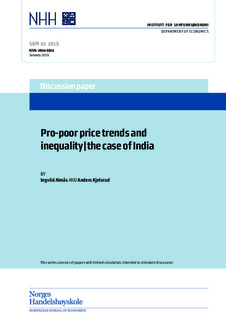| dc.description.abstract | It is well known that people's consumption patterns change with income. Relative price
changes therefore affect rich and poor consumers differently. Yet, the standard price indices are not income-specific and hence, the use of these mask these differences in cost-of-living. In this paper, we study consumption inequality in India, while fully allowing for non-homotheticity. Our analysis shows that the changes in relative prices in a large part of the period from 1993 to 2012 were pro-poor, in the sense that they favored the poor relative to the rich. As a result, we also find that the standard measures significantly overestimate the rise in real inequality. Moreover, we show that the allowance for non-homotheticity is quantitatively much more important in our application than the adjustment for substitution in consumption, despite the larger attention paid to the latter in the literature. We also illustrate how conventional measures exaggerate inter-temporal changes in inequality when there is segregation in consumption/production, by which we mean that people's consumption patterns are skewed towards goods intensively produced by people of their own group. | nb_NO |
